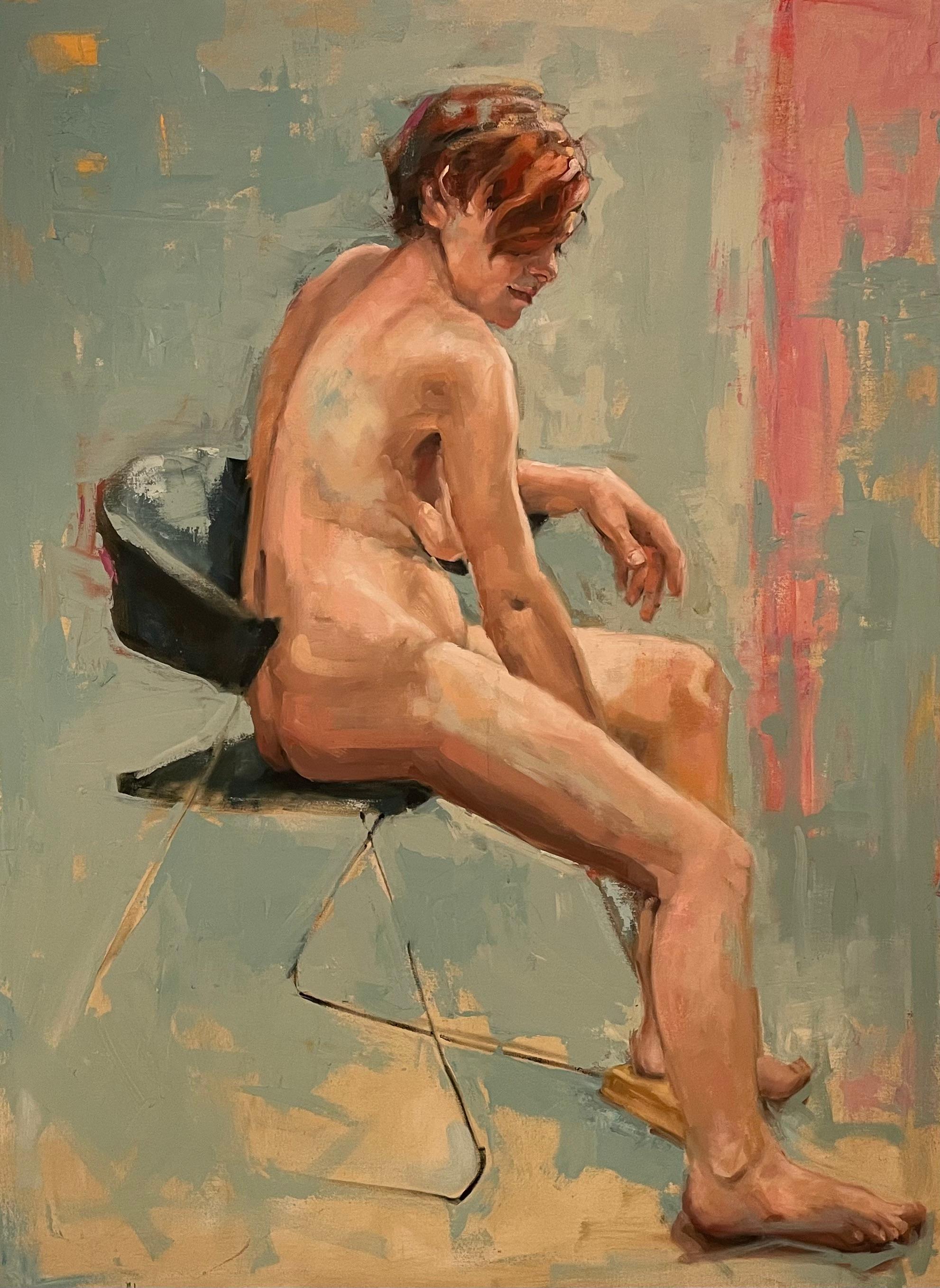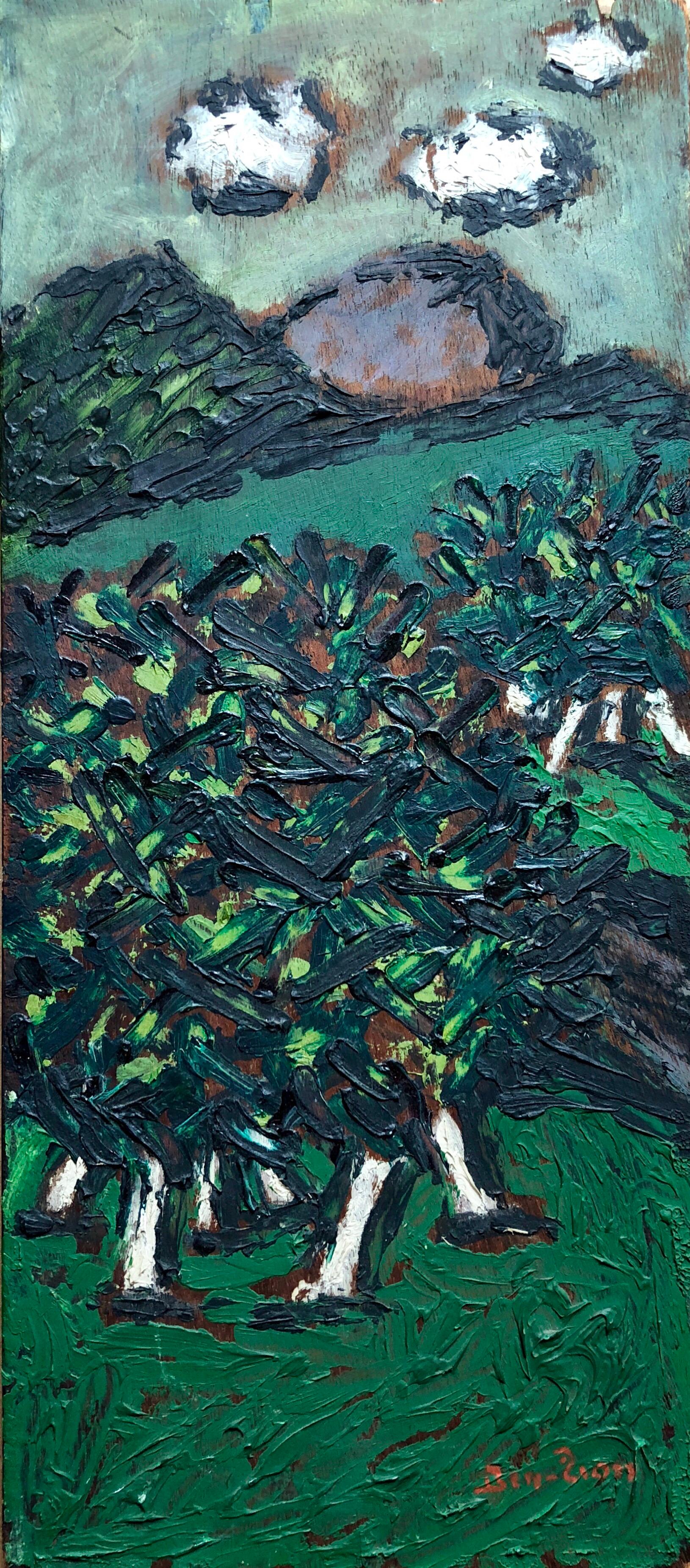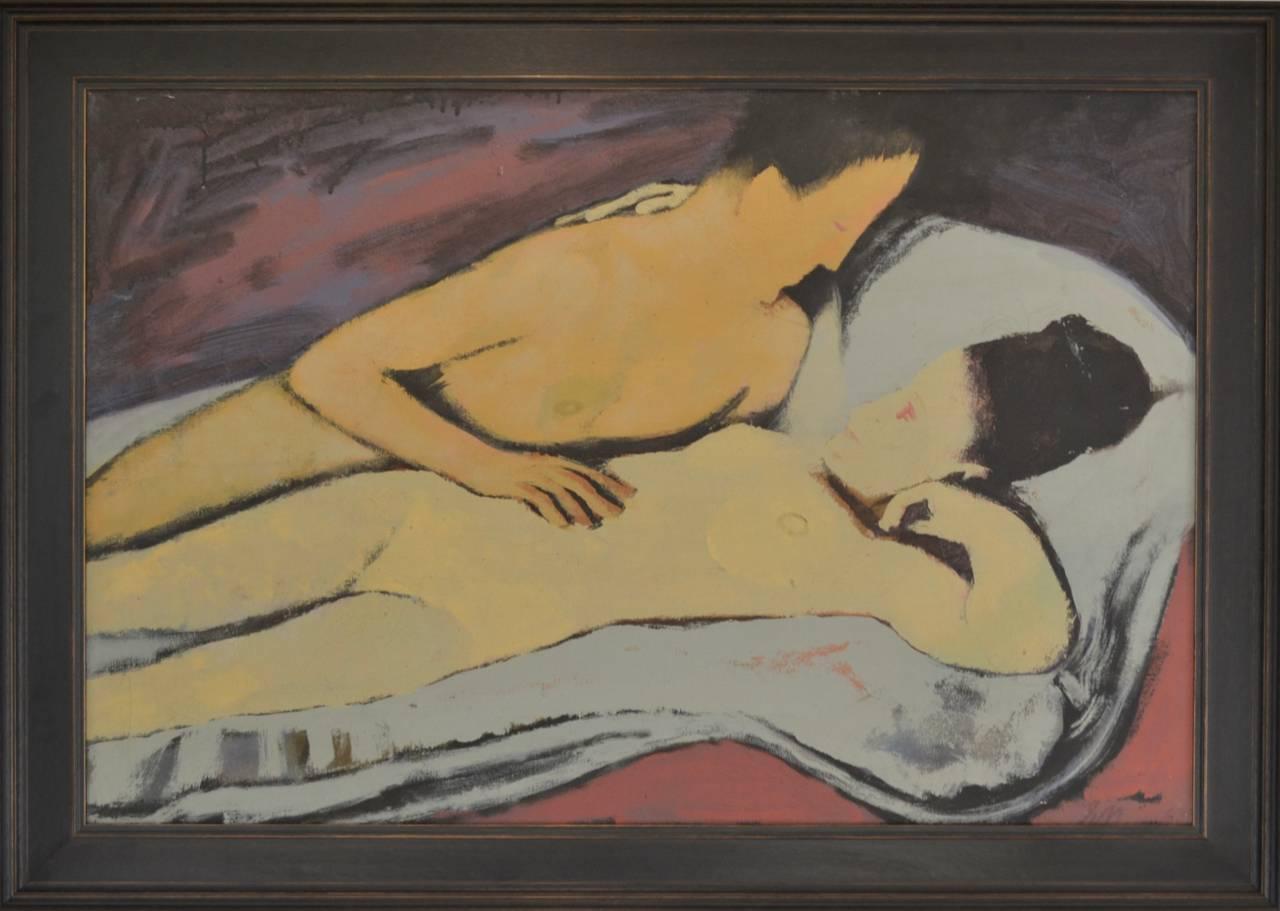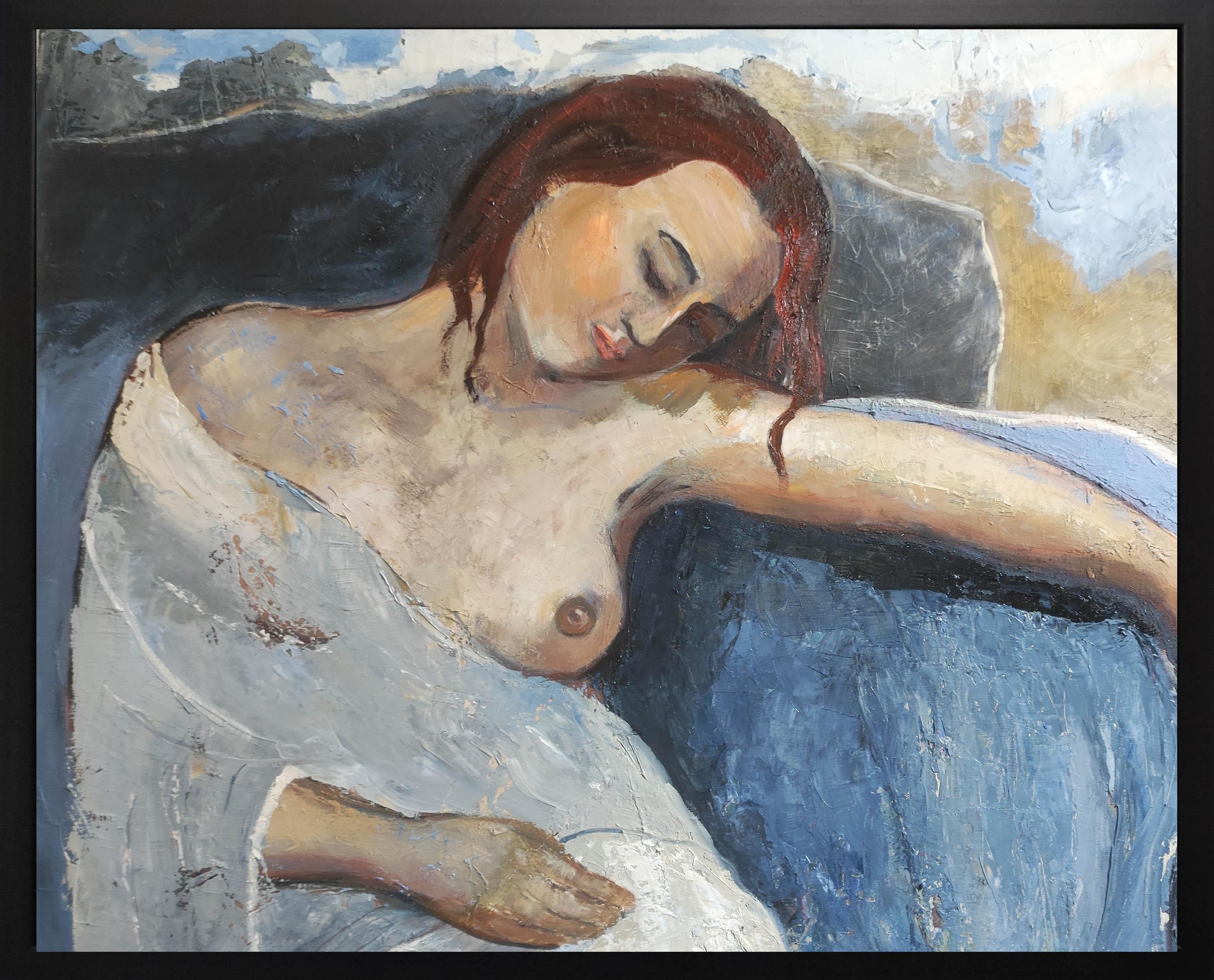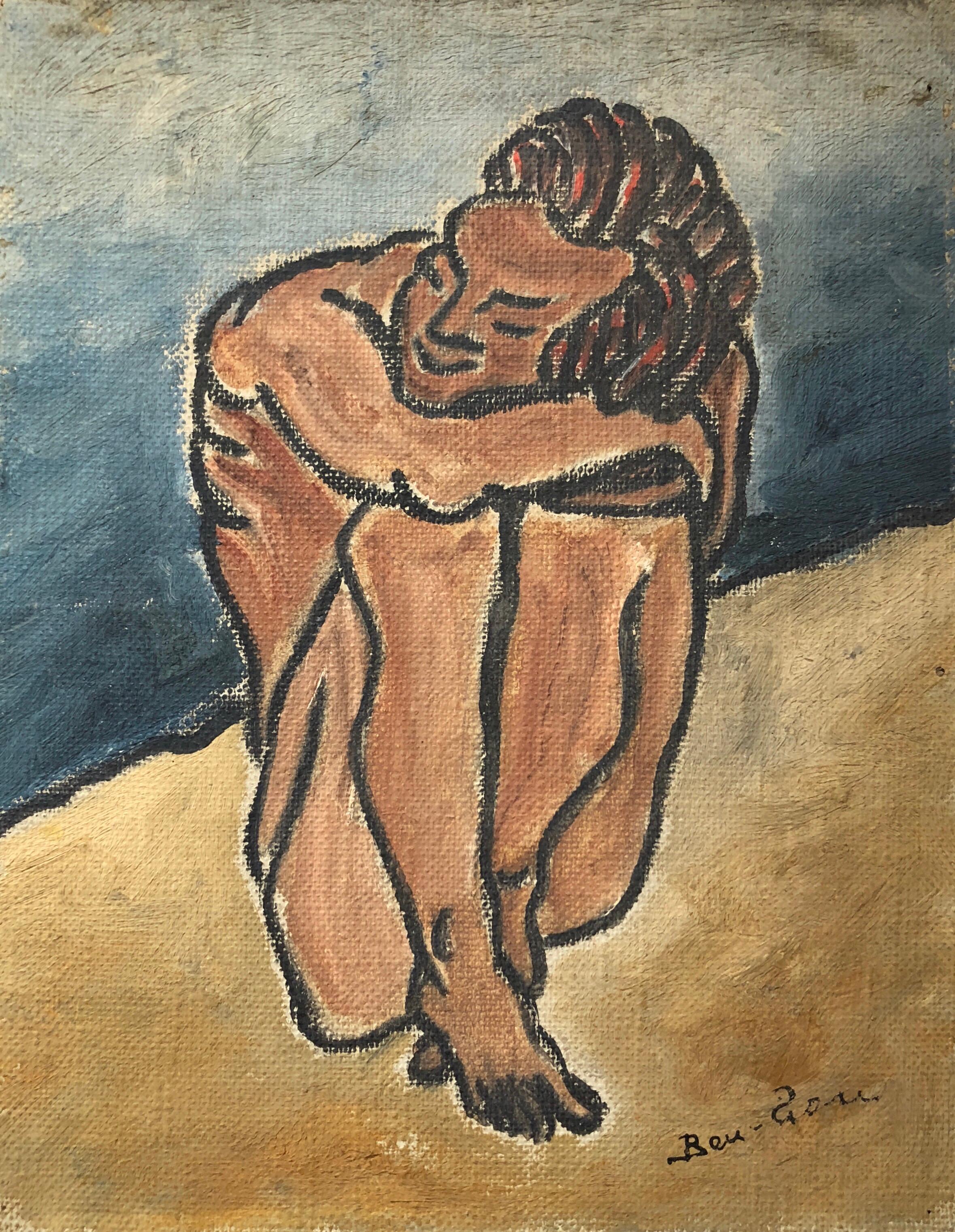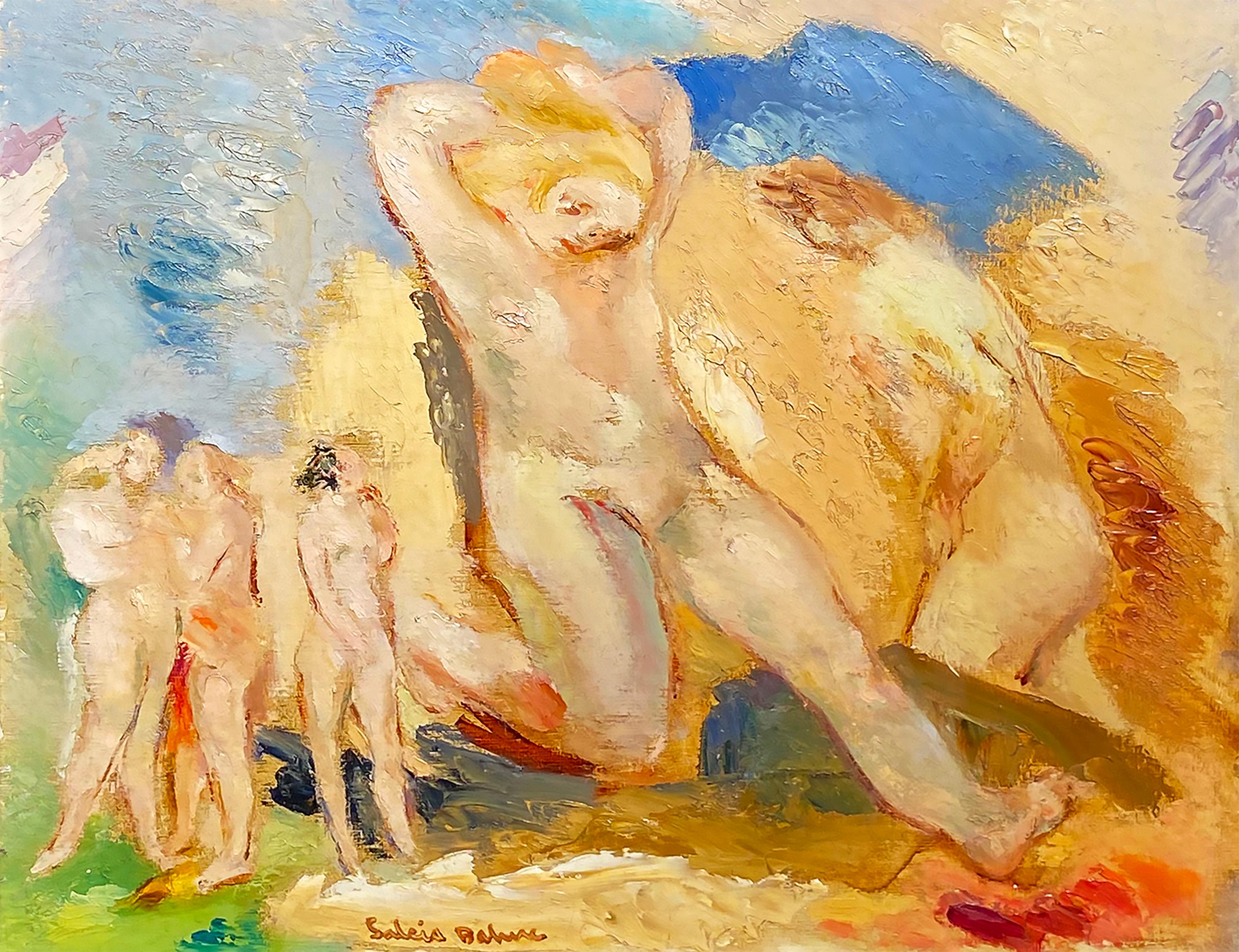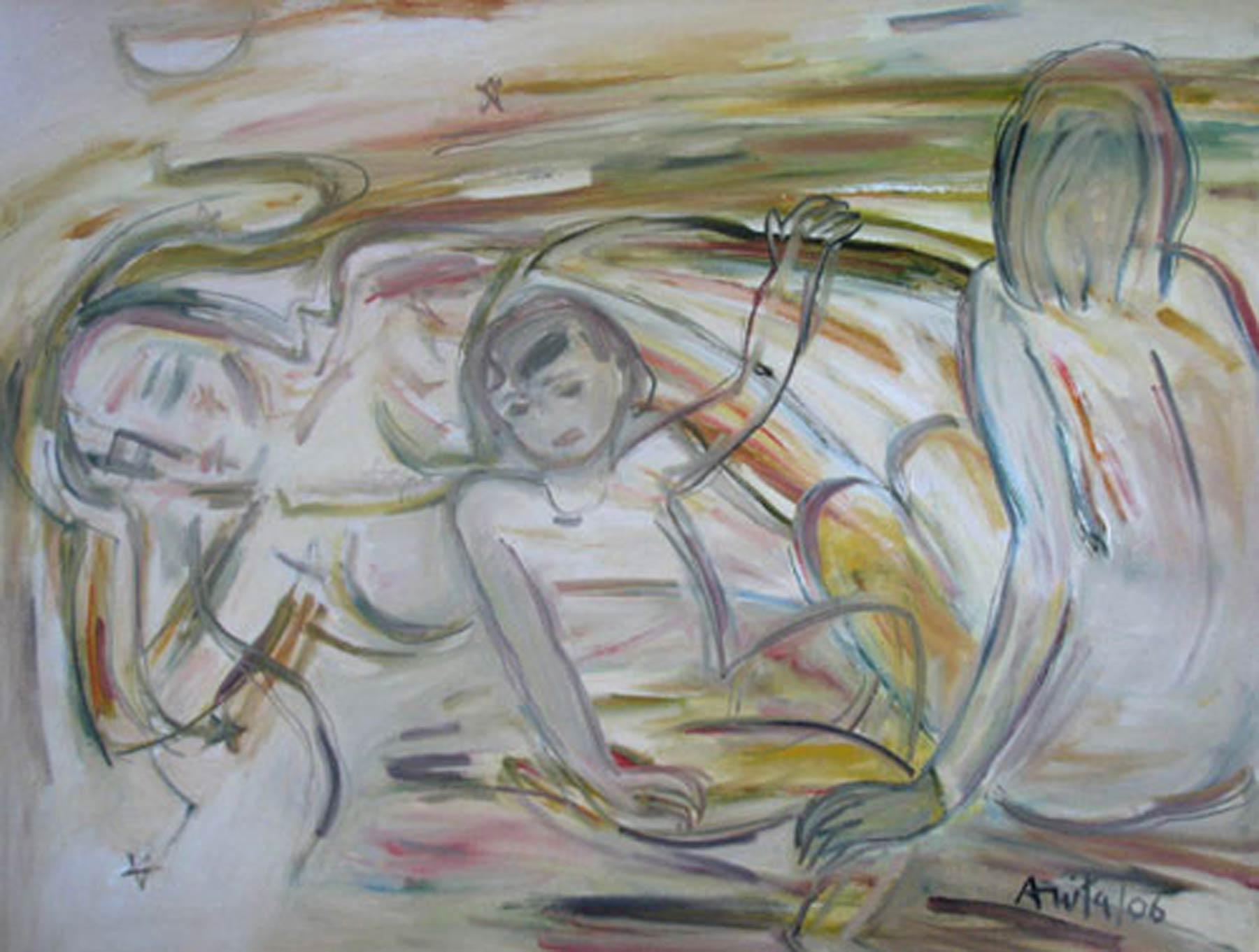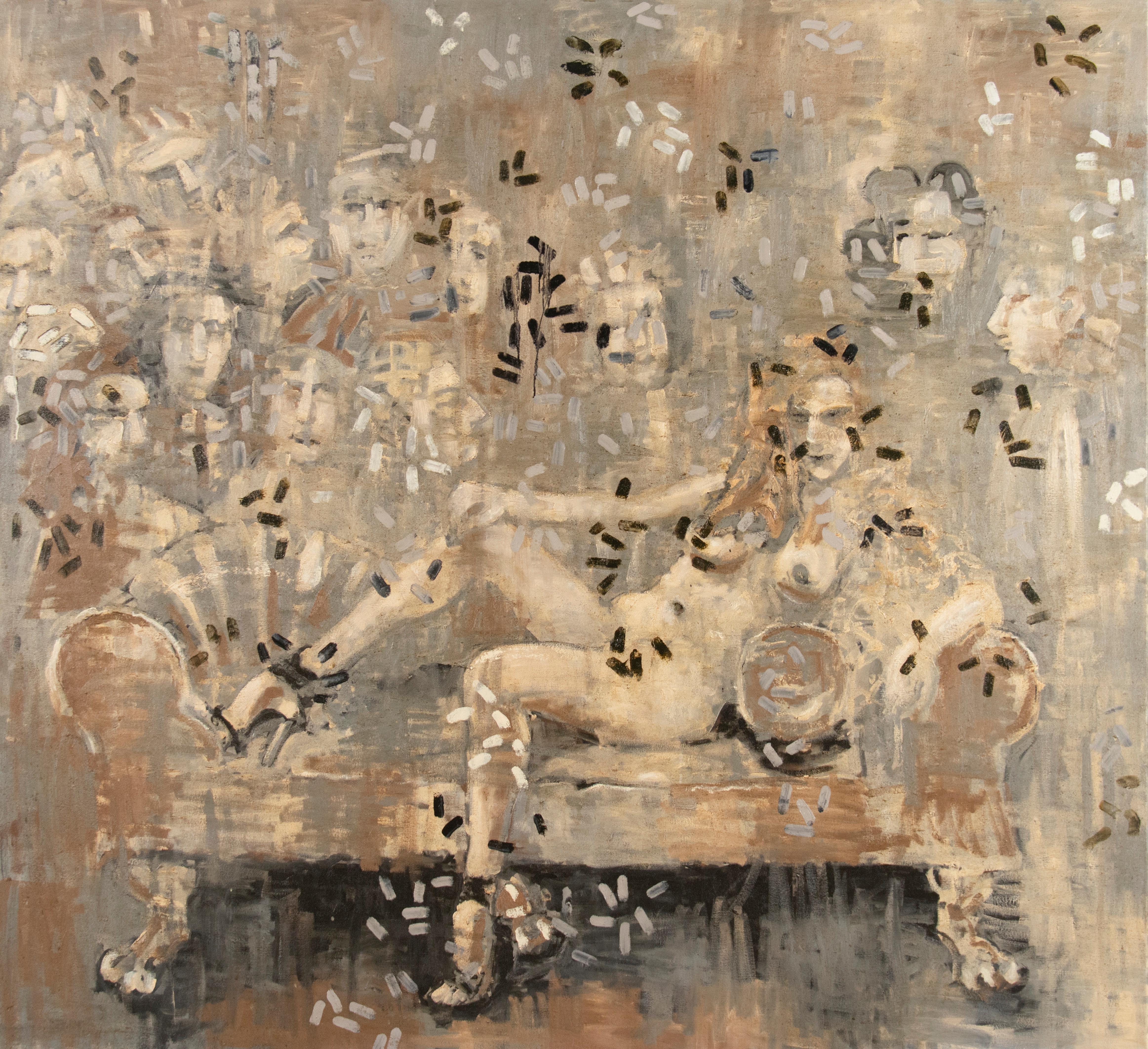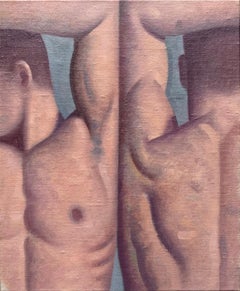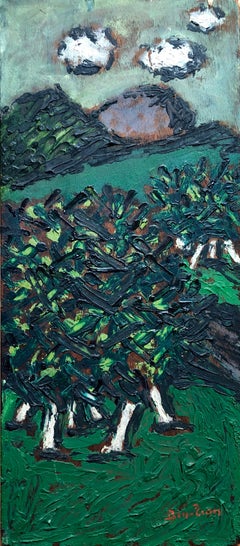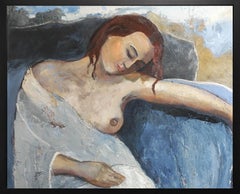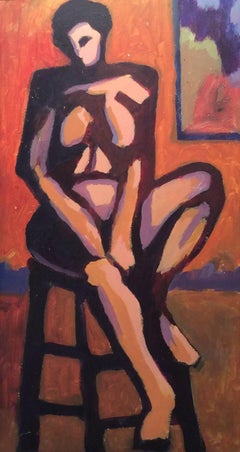
Seated Nude (Abstracted Figurative Female Nude Painting on Panel, Black Frame)
View Similar Items
Want more images or videos?
Request additional images or videos from the seller
1 of 8
Stephen BrophySeated Nude (Abstracted Figurative Female Nude Painting on Panel, Black Frame)1975
1975
About the Item
- Creator:
- Creation Year:1975
- Dimensions:Height: 25 in (63.5 cm)Width: 16 in (40.64 cm)
- Medium:
- Movement & Style:
- Period:
- Condition:
- Gallery Location:Hudson, NY
- Reference Number:1stDibs: LU2271294693
About the Seller
5.0
Platinum Seller
These expertly vetted sellers are 1stDibs' most experienced sellers and are rated highest by our customers.
Established in 1991
1stDibs seller since 2013
Typical response time: 2 hours
More From This SellerView All
- Anatomy Lesson No. 52 (Figurative Painting of Male Nude Pair on Blue Panel)By Robert GoldstromLocated in Hudson, NYFigurative painting of a pair of male nude torsos on a light denim blue backdrop "Anatomy Lesson No. 52, Study", painted by Hudson Valley artist, Robert...Category
2010s Modern Figurative Paintings
MaterialsPanel, Oil
- Anatomy Lesson No. 67 (Figurative Painting of Male Nude on Sky Blue)By Robert GoldstromLocated in Hudson, NYFigurative painting of male nude torso on a blood orange background "Anatomy Lesson No. 67, Study", painted by Hudson Valley artist, Robert Goldstrom in...Category
2010s Contemporary Figurative Paintings
MaterialsPanel, Oil
- Weightless, Timeless: Oil Painting of Two Women Swimming in PoolBy Samantha FrenchLocated in Hudson, NYHorizontal figurative photo-realist painting of women swimming in an aqua blue pool "Weightless, Timeless," painted by Hudson Valley artist, Samantha French, is 2019 oil on canvas, 48 x 60 inches Sides are cleanly painted white so additional framing is optional Excellent condition and ready to hang as is This photorealist figurative painting captures a peaceful water scene of a women leisurely floating in a crisp, aqua blue pool. The sunlight reflecting off their sun kissed skin complements the cool color palette, making for a serene visual experience. The brush work is highly detailed with little texture (impasto) on the surface. The horizontal painting on canvas is currently unframed and has clean, white painted sides, so additional framing is optional. About the Artist: Born and raised in north central Minnesota, Samantha French graduated from the Minneapolis College of Art and Design in 2005. French’s current body of work explores the idea of escape, the tranquility and nostalgia for the lazy summer days of her childhood. The series is inspired by Samantha’s own reflections and memories of her childhood summers spent in the lakes of Northern Minnesota. French actively exhibits her paintings and is included in many private and public collections throughout the country while her work has garnered extensive international and national press. She is a full-time painter and keeps a studio in New York’s Hudson Valley. "My current body of work is focused on swimmers underwater and above. Using vague yet consuming memories from my childhood summers spent immersed in the tepid lakes of northern Minnesota, I attempt to recreate the quiet tranquility of water and nature; of days spent sinking and floating, still and peaceful. These paintings are a link to my home and continual search for the feeling of the sun on my face and warm summer days at the lake. They are my escape, a subtle reprieve from the day-to-day. At the same time, I am drawn to an idealistic time before my own, where swim caps and wool swimsuits were commonplace. This combination of memory, observation and photography has allowed me to preserve the transitory qualities of water and remembrance." Artist Resume: 2019 Winter Swim, Rubine Red...Category
2010s Photorealist Figurative Paintings
MaterialsCanvas, Oil
- Le Martyr de Saint Sebastian (Academic Figurative Oil Painting in Gold Frame)By Mark BeardLocated in Hudson, NYAcademic style figurative oil painting on canvas 48 x 24 inches unframed 58 x 32 x 3 inches in gold leaf wood frame This vertical, contemporary figurative painting of Le Martyr de Saint Sebastian was made by Mark Beard under his fictitious artistic persona, Hippolyte-Alexandre Michallon. Painted in a modern Academic style, Beard paints this Christian saint with dramatic detail and emotional gravity. The scene is a common artistic depiction of Sebastian who according to traditional belief, was killed during the Roman emperor Diocletian's persecution of the Christians. Here the artist depicts a nearly nude Saint Sebastian standing stoically while tied to a rustic brown post. A lush green forested terrain decorates the background while a white neo-classical building sits in the distance, which is perhaps the tomb where Saint Sebastian's remains were laid to rest. Saint Sebastian's pale blue-grey, stone-like stone tone is characteristic of Mark Beard's work who often portrays muscular young men similarly to Greek statues. The vertical Academic style figurative oil painting is complimented with a vintage style gold leaf wood frame. The painting is signed 'H. A. Michallon 1872' in red oil paint in the lower right corner. The gold frame is also signed and inscribed with black oil paint in several places (please see images). Mark Beard is a contemporary artist who made this work under the pseudonym Hippolyte A. Michallon who painted during the late 1800's so slight wear (see images) is intentionally staged to align with the factitious artist's purposed history. About the artist: Mark Beard is perhaps the most literal example of an artist pulled in so many different directions that he chose to “invent” six different personae in which to channel his overflowing energy and need for expression. Each painting style is radically different from the next, so it remains entirely believable that the work could stem from six completely different people of different time periods and different schools of thought. With a background in set design, Beard has always been one who could conjure total magic with anything available. Mark Beard has exhibited with Carrie Haddad Gallery for nearly twenty years and there has never been a dull moment. Mark Beard, born in 1956 in Salt Lake city, now lives in New York City. His works are in museum collections worldwide, including the Metropolitan Museum of Art, New York City; the Museum of Modern Art, New York City; the Whitney Museum of American Art, New York City; the Boston Museum of Fine Arts; and the Harvard, Yale, and Princeton University Art Museums; among many others. We would not be the least bit surprised to see new ‘personas’ emerge in the coming years. About: Hippolyte - Alexandre Michallon, 1849 -1930 The long and peripatetic artistic career of Hippolyte-Alexandre Michallon began in a conventional fashion. The only son of prosperous bourgeois parents in Tours, he first studied drawing with his mother, an accomplished amateur painter of insects. His father, an undertaker who appreciated his son's talent and supported his ambition to become a painter, sent him to Paris at age sixteen to enroll in the studio of Francois-Edouard Picot (1786-1868), an eminent history painter and professor at the Ecole des Beaux-Arts, with whom he studied for three years, until Picot's death. Under his aging teacher's guidance and tutelage, Michallon entered the preliminary stages of the Prix de Rome contest at the Ecole three times, winning an Honorable Mention in 1869 for his composition entitled The Solider of the Marathon. For the next twenty years Michallon regualarly exhibited paintings on historical and biblical themes at the Paris Salon, as well as commissioned portraits. By his own account, the most ambitious work of Michallon's career was a thirty-foot canvas depicting Noah's Ark, which he exhibited in the Salon in 1875. Michallon began painting atmospheric but zoologically correct images of exotic animals in the wild. These achieved a certain popularity among French and foreign collectors alike, providing Michallon with financial security for the first time in his career. Michallon moved to England in 1893. His outstanding technical skills easily earned him a position on the faculty of the Slade School of Art in 1900. The craze for animal paintings proved short-lived. He continued to teach at Slade for the next two decades, but his classes gradually dwindled in size as the academic approach and methods he espoused went from outmoded to downright unpopular. Finally in 1922, finding himself reduced to a single pupil, the talented young American Bruce Sargeant, he retired from Slade, persuading Sargeant to leave with him and undergo private instruction at home. Several years later he retired to a cottage at St. Ives, Cornwall, where he lived quietly until his death in 1930, forgotten by all but a few former students, among them Edith Thayer Cromwell...Category
Early 2000s Academic Figurative Paintings
MaterialsCanvas, Oil
- Vase of Pinks (Abstract Still Life Painting of Light Purple and Pink Flowers)By David KonigsbergLocated in Hudson, NY"Vase of Pinks" exemplifies all the hallmarks of a David Konigsberg painting: abstract liberties within representation, a rapturous handling of color, and an aesthetic that seamlessl...Category
2010s Contemporary Still-life Paintings
MaterialsPanel, Oil
- From Germantown II (Plein Air Winter Landscape of Hudson River & Mountains)By John KellyLocated in Hudson, NYGestural, en plein air winter landscape painting of the Hudson River Valley and Catskill Mountains Painted in January of 2024, by Hudson Valley based ar...Category
2010s Contemporary Landscape Paintings
MaterialsOil, Wood Panel
You May Also Like
- "Young Woman Seated" Green & Pink Contemporary Figurative Nude by Shana WilsonBy Shana WilsonLocated in Carmel, CAIn "Nude Woman Seated," a 40" x 30" oil on wood panel by Shana Wilson, there is an intimate portrayal of vulnerability and quiet strength. The artist employs a soft, earth-toned palette, with shades of warm beige, muted greens, and accents of coral, to craft the figure’s delicate form. Wilson's loose, confident brushstrokes lend a raw, textured quality, while the interplay of light and shadow captures the natural curves of the human body. The solitary figure, caught in a moment of repose, exudes a contemplative air, inviting viewers to reflect on the complexities of the human form and the subtle narratives contained within stillness. About the Artist: Over seven billion souls exist on this planet, each with a unique face and story. Shana transfers her visceral love for the human landscape to canvas, tenderly cradling its peaks and valleys, darkness and light, colors and neutrals, empty and full, hard edges and soft curves. Each brush stroke creates a controlled cacophony as it assembles the intricate jigsaw of the human face. An entire life’s journey is written on this human landscape; a journey that begs to be documented and treasured. Shana’s legacy project is to paint inspirational women from all walks of life, inclusive of all cultures and orientations. The subjects all have one thing in common; the ability to inspire and create social change. She pays tribute to them on canvas, painting a long overdue celebration of trail-blazing women. Visit any major gallery or museum in the world and it is teeming with paintings of nude women...Category
21st Century and Contemporary Expressionist Figurative Paintings
MaterialsWood Panel, Oil
$7,500 Sale Price25% Off - American Modernist Oil Painting Gestural Landscape WPA Artist Group of 10By Ben-Zion WeinmanLocated in Surfside, FLBorn in 1897, Ben-Zion Weinman celebrated his European Jewish heritage in his visual works as a sculptor, painter, and printmaker. Influenced by Spinoza, Knut Hamsun, and Wladyslaw Reymont, as well as Hebrew literature, Ben-Zion wrote poetry and essays that, like his visual work, attempt to reveal the deep “connection between man and the divine, and between man and earth.” An emigrant from the Ukraine, he came to the US in 1920. He wrote fairy tales and poems in Hebrew under the name Benzion Weinman, but when he began painting he dropped his last name and hyphenated his first, saying an artist needed only one name. Ben-Zion was a founding member of “The Ten: An Independent Group” The Ten” a 1930’s avant-garde group, Painted on anything handy. Ben-Zion often used cabinet doors...Category
Mid-20th Century Expressionist Figurative Paintings
MaterialsOil, Wood Panel
- feminnity, blue nude woman, oil on canvas, figurative, contempory paintingBy SOPHIE DUMONTLocated in LANGRUNE-SUR-MER, FRThe body is a wordless poetry that painting brings to life. portrait of a seated woman, bare breasts and a white drape over her thighs. the woman is asleep and the painting inspires ...Category
21st Century and Contemporary Expressionist Nude Paintings
MaterialsOil
$3,398 Sale Price20% Off - American Modernist Oil Painting Nude Male on Beach WPA Artist Group of 10By Ben-Zion WeinmanLocated in Surfside, FLBorn in 1897, Ben-Zion Weinman celebrated his European Jewish heritage in his visual works as a sculptor, painter, and printmaker. Influenced by Spinoza, Knut Hamsun, and Wladyslaw Reymont, as well as Hebrew literature, Ben-Zion wrote poetry and essays that, like his visual work, attempt to reveal the deep “connection between man and the divine, and between man and earth.” An emigrant from the Ukraine, he came to the US in 1920. He wrote fairy tales and poems in Hebrew under the name Benzion Weinman, but when he began painting he dropped his last name and hyphenated his first, saying an artist needed only one name. Ben-Zion was a founding member of “The Ten: An Independent Group” The Ten” a 1930’s avant-garde group, Painted on anything handy. Ben-Zion often used cabinet...Category
Mid-20th Century Expressionist Figurative Paintings
MaterialsOil, Board
- Seated NudeBy Helge HelmeLocated in New York, NYAxel Henry Helge Helme (1894 Roskilde, Denmark 1987), Seated Nude, circa 1930, oil on canvas, original frame Son of a merchant, Helge Helme was admitted ...Category
20th Century Expressionist Nude Paintings
MaterialsOil, Canvas
Price Upon Request - NudesLocated in Missouri, MONudes By. Salcia Bahnc (Polish, American, 1898-1976) Signed Lower Middle Unframed: 14 x 18 inches Framed: 23 x 26 inches Painter, illustrator, printmaker, teacher. Born in Dukla, Poland. Though she was born in Dukla, a town in south-eastern Poland, she moved to Prsemysl, one of the largest and most ancient cities of southern Poland, at a young age. Her mother was reportedly descended from the "Van Ast" family, a Dutch dynasty that produced several artists, including Balthasar van der Ast (1593/4 - 1657). According to one art historian she came to New York at the age of five (c. 1903), and another, at the age of eight (c. 1906). Her family was Jewish and reportedly quite wealthy. Why they would have left imperial Austria, under whose sovereignty either of her proposed birth cities were under, is unknown. However, while these areas did not suffer the pogroms typical in neighboring imperial Russia, the Austro-Hungarian empire had become much more anti-Semetic, which may have hasten there departure. How, according to one source, they ended up living in the Jewish ghetto of New York is extremely puzzling. Did they loose their wealth to some business disaster? Where they forced to leave it behind? Was there some familial tragedy? We may never know. In her youth she lived first in New York City and then in Boston, Massachusetts, where her family had relatives. It is reported that when she was in fourth grade she was found to be so competent in drawing that for the next two years she taught a drawing class after school for the other children. In Boston, Bahnc's mother eventually remarried and moved the family to Chicago where the young artist was primarily raised. In Chicago she worked during the days as a sales clerk in a department store. At night she put herself through school at the School of the Art Institute of Chicago (SAIC) and taught at her former alma mater after her graduation during the years 1923-1929. She also studied at the Chicago Academy of Fine Art. She took up design work and began exhibiting painted silk creations at a private Chicago gallery (probably Thurber, see below). The first museum exhibitions she is known to have participated in were held at the Art Institute of Chicago. During this period she became known for her portraits. Originally a resident alien, she was naturalized at the district court of Chicago, Illinois in July of 1913. In 1920 she lived on East Ontario Street in Chicago in a neighborhood filled with art studios and artists, including James Allen Saint-John (1872-1957), Paul Bartlett (1881-1965), Pauline Palmer (1867-1938), and George Ames Aldrich (1872-1941). It is in Chicago that she saw her greatest success as an artist. In 1927, Chicago art dealer Chester H. Johnson said of her work: "The Art of Salcia Bahnc is a sincere manifestation of the spirit we know as 'Modernism' . . . . . . She is the spirit of the Age, not its Fashion." Local reviewers agreed, one going as far to say that her exhibition was " . . . the most interesting one man show by a young artist that has ever been presented to Chicago, and I keep telling myself that New York will get her if we don't watch out." She was apparently a favorite and friend of art critic Clarence Joseph Bulliet (1883-1952), who authored a number of books and articles that praised Bahnc's work. Bulliet was central in introducing and popularizing modern art in the mid-western United States. In his book Apples and Madonnas: Emotional Expression in Modern Art (1935) he called Bahnc a "A thorough Expressionist." A year later in his book The Significant Moderns and Their Pictures (1936) he noted that one of her paintings of a nude was ". . . powerful in its elemental brutality." During this period other critics reported positively on the work she was producing. Ida Ethelwyn Wing reported in a volume of the Delphian Text (1930) that Bahnc, was without doubt, ". . . the most vigorous and intensively original of the American Expressionists." Paul Masserman and Maxwell Baker said of her in their work The Jews come to America (1932) that she was part of a group of artists that were "Chief among modern Jewish painters. . . " Salcia Bahnc traveled back and forth to Europe during the late 1920s and into the 1930s, a period when she faced the rise of totalitarianism. She wrote about this fact to a fellow artist to whom she commented " . . . about the difficult art scene in Paris . . . . . . and the growing power of fascism." In 1930 she was maintaining a studio in New York City at 1218 East 53rd Street and a residence in Brooklyn, Long Island. She returned to France where she married a French citizen and writer named Eugene Petit (b. 1901) and bore a son there named Alain Petit (b. 1934). She again returned to the United States in November of 1937 and traveled back to France after a brief stay in America. During her stay she continued to exhibit in Chicago, where Quest Galleries gave her a solo show. Like so many ex-patriot authors and artists who were living in Paris, she found herself trapped in France (first in Paris, then in Mayenne) following the German invasion in 1940. Being of Jewish extraction the situation could prove to be quite dangerous if she were reported or discovered by German authorities. She and her husband were able to obtain passports and escape to Portugal where in August of 1941 they boarded the S. S. Escambion to return to America. In 1940, American Export Lines, owners of the Escambion, discontinued its normal Mediterranean routes and placed their ships into service sailing from Lisbon, Portugal to New York City. Over the next two years (1940 - 1941) their ships played an important role in transporting thousands of people who were trying to escape the Nazi regime before America's own entry into World War II. One survivor, Ludwig Lowenberg, who sailed on the Escambion on the same day that Bahnc did, reported the ordeal his family endured getting to Lisbon to his own descendants: "[The family] received their American visa on May 28, 1941, only three days before the U.S. consulate in Stuttgart closed for the duration of World War II. They left Berlin on June 23, 1941, traveling for 27 hours on a locked train to Paris. There they were forced to spend an additional night in the locked train until their coach was attached to a train headed for San Sebastian in Spain. After an overnight hotel stay in San Sebastian, the train (now no longer locked) continued to Lisbon. All in all it took six days from Berlin to Lisbon. They remained for four weeks in Lisbon until they embarked on the Excambion for New York." Bahnc had given up her citizenship during her time in France and was forced to reapply for naturalization once again upon her return. She was living in New York City at 101 West 85th Street when she was re-naturalized in April of 1947. Exactly how much of her artwork was lost in Europe is not known. Clearly, she would not have been able to bring much, if anything, with her during her escape. One writer had noted that between 1930 and 1934 she had worked hard to prepare a large group of new works for a show in Paris. Between those, and what she would have produced during the next six years, the actual amount of the loss might have been staggering. Bahnc's 1942 exhibition with Julio de Diego included works recalling the suffering going on in Europe. One work in the exhibition was a portrait of the painter Katherine Dudley, who, at the time, was reportedly interned near Paris. In the later years of her career she worked extensively as a teacher and illustrator of children's books. In 1950 she taught at the Evanston Art Center, where she lead a demonstration in portrait painting. She authored or illustrated a number of works during and after World War II, including: The House in the Tree and Other Stories of Places, People and Things (1941); Claude Of France: The Story Of Debussy For Young People (1948); Time for Poetry (1951); Hidden Silver (1952); From Many Lands - The Children's Hour, Volume 9 (1969); and That Boy (no date). She returned to teach at the School of the Art Institute of Chicago during 1943-44 and 1947-53; and taught later at the Garrison Forest School in Garrison, Maryland, from 1955-57. Bahnc was known to have exhibited widely, both in Europe and in America. Her known lifetime exhibitions include: The Art Institute of Chicago, Chicago, IL, 1919-29, 1942 (The 53rd Annual; and Room of Chicago Art: Exhibition of Paintings by Salcia Bahnc and Julio de Diego), 1943; Chicago Architectural...Category
20th Century Expressionist Nude Paintings
MaterialsCanvas, Oil
Price Upon Request
Recently Viewed
View AllMore Ways To Browse
Academic Oil Nude
Nude Texas Artist
Male Nudes Oil Canvas
Antique Nude Oil Paintings
Oil Paintings Antique Nude
Nude Bather Painting
Male Nudes Oil On Canvas
Male Nude Oil Painting On Canvas
Cubist Nude Oil Painting
Vintage Oil Nude
Vintage Nude Oil Painting
Vintage Wrestling Art
Nude Bath
Framed Male Nude Oil
Nude In Bath
Female Nude Cubist
Nude Woman Oil Back
Pink Female Nudes Paintings
